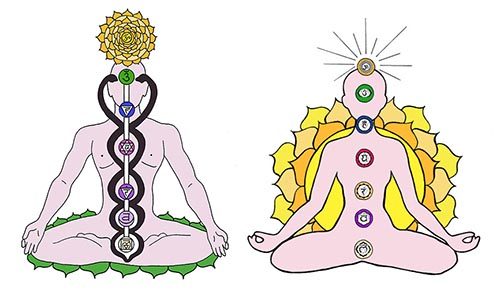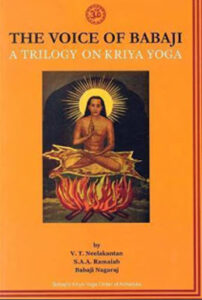Story of Mataji and Babaji
Mataji and her brother Babaji form a pair of immortal avatars in the Hindu tradition. Mataji is an Eastern adept in feminine form and an expression of the Divine Mother (Mata). Mataji is specifically viewed as the embodiment of compassion. Babaji is an ancient Indian yogi known as the Eternal Youth. Mataji is also revered as an feminine deity.
Roles of Male and Female Consorts
In the Hindu tradition, deities are almost always paired as male and female. Philosophically speaking, the male counterpart worships the feminine principle of energy (Shakti). In return, the female aspect worships the male principle of consciousness (Shiva).
Share this page with a friend!
Mantra to Mataji
Adi Mataji, Adi Mataji, Namo, Namah (2x)
Mataji Mama, Mataji Mama, Mataji Mama
Mataji Mama, Mataji Mama (2x)
Jaya Ma, Jaya Ma, Mataji Mama (2x)
As noted above, Mataji is not as well known as her brother Babaji. As a result, there are very few mantras in her honor. Adi Mataji was written (by Kathleen Karlsen) as a mantra to Mataji in her role as a representative of the Divine Mother.
Mantra Meaning and Translation
“Adi” means the primal or first mother. “Jai” or “jaya” means victory. Mataji is venerated as a yogic master representing the Divine Mother. The meaning of this chant is “Victory and honor to the Divine Mother Mataji!”
Mataji as a Mother Goddess
Mataji is sometimes viewed as the romantic consort or partner of Babaji rather than his sister. More is known about Babaji than about Mataji. However, there is a vast amount of information and stories about the various manifestations of the Divine Mother. Mataji is also a term that can refer to various goddesses, especially Durga, Lakshmi, and Saraswati.
“Mataji” is a term of respect for a female spiritual teacher or for any woman who is unknown to the speaker. Sometimes Mataji is used interchangeably with other terms including Devi (God as a feminine being) or Prabhu (master or prince) in reference to spiritual devotees.
Watch nearly 400 videos on the Vocal Medicine Channel!
Roles of Mataji and Babaji
Both Mataji and Babaji are said to live in an ashram high in the Himalayas. This is a type of heavenly oasis with beautiful landscapes and a temperate climate. Only the most ardent devotees have been able to reach this abode.
In their secret Himalayan ashram high in the mountains, Mataji is said to have many responsibilities. Mataji takes care of the daily meal at noon and the organization of the ashram. She is in charge of rituals honoring Babaji, including feet washing and the offering of flowers. Mataji wears a white sari with a green border.
Babaji Agrees to Retain a Body
When Babaji planned to leave his physical body forever to be absorbed into the Infinite, Mataji requested that he always retain a physical form. Mataji reasoned that his students still needed to see him in a physical body. He agreed that his body would always be visible to at least a small number of disciples. Babaji is the guru and spiritual teacher for all students in his ashram.

Life of Babaji
The historic Babaji is said to have been born in 203AD. He lived on the east coast of India. His birth name was Nagaraj. Legends relate that he was kidnapped by pirates and sold into slavery. Nagaraj’s owner is said to have recognized that he had special gifts. Therefore, his owner decided to release him.
Taking the Name of Babaji
From that point, Nagaraj wandered and studied spiritual teachings. Nagaraj eventually came to be known as “Babaji,” which simply means “honored father.” He is said to have achieved immortality while still in his teens.
Babaji’s Yogic Practices
Babaji is an expert in the mastery of the root chakra or Muladhara chakra. He is said to have pledged to remain with the earth for the sake of yogic education of souls. The young Nagaraj practiced Siddha Yoga and Kundalini Yoga. He added his own developments to those practices, calling the new form of yoga by the name of Kriya Yoga.
Practicing the Cosmic Cobra Breath
One of the techniques created by Nagaraj is the Cosmic Cobra Breath. This is a spiritual technique that works on multiple dimensions to balance the brain. The Cosmic Cobra Breath is purported to alter the physiology of the brain, which in turn alters one’s world view and ultimately one’s consciousness.

Babaji’s Cosmic Cobra Breath
The Cosmic Cobra Breath specifically affects the third ventricle of the brain. The third ventricle is a funnel-shaped cavity of the brain in the midline between the two hemispheres of the diencephalon of the forebrain. This ventricle has been viewed as significant by the Sufis, Taoists, Buddhist and ancient Egyptians.
Cave of Brahma
This portion of the brain is called the Cave of Brahma by Hindus and the Crystal Palace by Taoists. The third ventricle houses the pineal, pituitary and hypothalamus glands. The pineal and pituitary glands are said to function as a pair, forming a balance of masculine and feminine energies called the Tantric Marriage. This practice is also said to clear the energy circuits known as nadis. The Cobra Breath can be used to transmute other forms of energy including sexual energy.
Mantra to Babaji
The mantra “Om Kriya Babaji Namah Aum” connects to the energy of Babaji. The word “kriya” means “completed action.” “Aum” is a variation of the word “Om.” Aum is more closely related to the crown chakra, while Om is often correlated with the third eye chakra.
Mataji and Babaji in the Modern World
Mataji and Babaji are purported to appear sporadically to devotees and pilgrims. They are able to manifest in either a spiritual or physical form. Although Mataji is the spiritual equal of Babaji, she has chosen the role of disciple to Babaji. Mataji is said to assist students in meditation.
Place in a Guru Lineage
Mataji and Babaji both appear in the Autobiography of a Yogi by Paramhansa Yogananda. Babaji is in the lineage of gurus that include Yogananda and his guru Sri Yukteswar Giri and Lahiri Mahasaya. Descriptions of Mataji and Babaji also appear in the book called The Voice of Babaji by V.T. Neelakantan.
The Divine Mother in Hinduism
The Divine Mother plays a huge role in Hinduism, sometimes receiving even more attention and devotion than God in masculine form. Each goddess has multiple attributes. Goddesses are often known by dozens, hundreds, or even thousands of names.
Goddess Names
Each name emphasize a particular quality of the goddess. “Shakti” is a general term for the energy that pervades the universe and gives rise to all form and action. In the Hindu tradition, the Divine Mother has seven basic forms: the biological mother, the wife of one’s teacher, the wife of a sage, a queen, the motherly aspect of cows, the mother earth and the mother of the universe.
The Biological Mother (Audau Mata)
Devotion to the biological mother is truly universal. The mother who provides directly for our survival needs as infants and children is revered around the world. This mother is our first teacher and our protector. She creates our first impressions of life.
Wife of One’s Teacher (Guru Patni)
In the Vedic tradition, children were sent to a type of boarding school beginning at age five. They learned both skills for success in the world and spiritual teachings. These students often lived at the home of their teacher or guru. The wife of the teacher was like a second mother.
Wife of a Sage (Brahmani)
Advanced spiritual practitioners or sages spent a good deal of their time preforming religious activities. The wives of these practitioners or sages often served as a counterbalance for the disciplines of religious life, providing for the needs of others with compassion and practicality.
The Queen (Raj Patnika)
A queen often sets the tone for those under the rule of a king and queen. In Vedic culture, the queen was viewed as a kind of royal mother, ensuring that policies and laws were for the benefit of all citizens.
Motherly Aspect of Cows (Dhenu)
In ancient India, milk was a significant food. The gentle nature of cows made them useful and beloved animals existing. Cows achieved a divine status and were protected and honored.
The Mother as Caregiver (Dhatri)
The Divine Mother as caregiver can take the form of a nurse, doctor, daughter, sister, aunt, grandma and so forth. The caregiver may be highly knowledgeable or simply perform basic tasks related to sanitation, comfort or feeding.
Mother Earth (Prithvi)
The personification of nature as Mother Earth is extraordinarily common in world cultures. In the Hindu tradition, Mother Earth is the consort of Dyus Pita (Father Sky). She is also present in Buddhist texts as the witness for the enlightenment of Gautama.
Learn more in the article Jagadamba: Mother of the Universe.
MATAJI ARTICLE SUMMARY
Mataji is venerated as a yogic master representing the Divine Mother. Mataji is the sister of Babaji, an ancient Indian yogi known as the eternal youth. Although Mataji is the spiritual equal of Babaji, she has chosen the role of disciple to her brother. Mataji and Babaji are an example of the Hindu tradition of saints and deities appearing in both masculine and feminine form, in this case some view them as siblings rather than as romantic partners. Article includes videos and a mantra recording.
Click for all content on our Site Map
Author Kathleen Karlsen
Kathleen Karlsen is a musician, artist, writer and speaker. She is the author of two books (Flower Symbols and Vocal Medicine) and over 200 articles. Kathleen, her husband Andrew, and their five children live in Bozeman, Montana. More about Kathleen Karlsen.
Watch nearly 400 videos on the Vocal Medicine Channel!
Share this page with a friend!
![]() Vocal Medicine Music on Spotify!
Vocal Medicine Music on Spotify!






